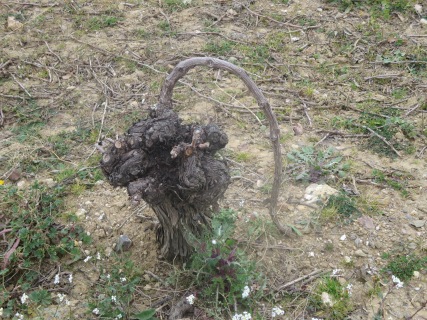In my last post I published this photograph showing a vineyard in Margon. I thought it was a lovely picture of a healthy vineyard with biodiversity in the spring warmth. Celandines (yellow), wild rocket (white) and marigold (orange) all growing nicely in the sunshine.
Well, it turns out I was wrong! A certain M. J-FC from Puimisson tells me that the marigolds are actually a possible problem. (Incidentally the word for marigold in French is souci, which also means care or worry so these are living up to their name). Marigolds grow in soil with a lot of nitrogen, perhaps the result of nitrogen based fertilisers. Nitrogen is vital for plant growth, helping to boost photosynthesis for example, but too much is not good for vines. Why? Time to do some homework.
As the vine grows it must develop greenery in the form of shoots (to support the vine which is a climbing plant) and leaves (for photosynthesis) as well as its fruit, the grapes. Too much nitrogen produces a surplus of sugars which may cause the vine to favour its greenery over the fruit. Too much greenery can cause too much shade, therefore grapes don’t ripen properly. Too much greenery also increases the risk of fungal disease as air cannot circulate so easily.
Getting the balance right is one of the many tightropes the viticulteur must walk. Getting nitrogen into the soil is important and crop covers can help which is why ploughing plant life into the soil is useful (see post Teamwork) but too much nitrogen and you can cause problems for later in the season. The winegrower’s life is, indeed, plein de soucis!
Meanwhile can anyone tell me why this guyot trained vine has its cane replanted back into the earth at its tip? It was one of a whole vineyard trained like this near Faugeres. Is it to support the vine which is untrellised? To keep the fruit close to the ground?
As the support title for the blog says I am “Learning about wine, vines and vignerons whilst living in the Languedoc”. I have a lot more learning to do, so thank you for this lesson Jeff!



March 4, 2015 at 4:36 pm
Good article Alan. It’s great to see you investigating and learning about a lot of the things that the more romantic (and manipulative) commentators would like us to take for granted. Biodiversity is a pretty complex subject. And that’s before we get onto the environmental issues of having wild flowering plants in a vineyard that we are planning to spray with a pesticide – organically-certified or not.
LikeLike
March 4, 2015 at 4:42 pm
I forgot to mention that the vigneron burying the cane is probably attempting layering to create a new plant from the cane. It was once the common practice of replacing missing vines but not such a great idea now we have phyloxera. Another example of why we can’t just continue to grow vines the way our ancestors (well not mine) did hundreds of years ago. We have to find new solutions to new problems.
LikeLiked by 1 person
March 4, 2015 at 5:25 pm
Thanks Jonathan. Yes preconceptions and the romantic views of back to nature have certainly rubbed against reality. I was genuinely surprised when Jeff told me about the marigolds and enjoyed reading around the subject, there are so many decisions and forks in the road for winemakers with short and long term consequences both beneficial and harmful. A vineyard is a minefield 🙂
I see what you mean about the vine yes that would make sense. I had never seen it before, couldn’t find any pictures or mentions of it so was genuinely puzzled. There was a good acre or so of vines like that,, very isolated so maybe some kind of nursery system. Thanks again.
LikeLike